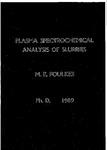PLASMA SPECTROCHEMICAL ANALYSIS OF SLURRIES
| dc.contributor.author | FOULKES, MICHAEL EDWARD | |
| dc.contributor.other | School of Geography, Earth and Environmental Sciences | en_US |
| dc.date.accessioned | 2013-09-24T11:26:20Z | |
| dc.date.available | 2013-09-24T11:26:20Z | |
| dc.date.issued | 1989 | |
| dc.identifier | NOT AVAILABLE | en_US |
| dc.identifier.uri | http://hdl.handle.net/10026.1/1928 | |
| dc.description.abstract |
The analysis of ores, minerals and refractory materials by slurry atomisation has been investigated using inductively coupled plasma and direct current plasma-atomic emission spectrometry (ICP-AES, DCP-AES) and inductively coupled plasma-mass spectrometry (ICP-MS). Aqueous calibrants were used. Fundamental aspects were modelled. The particle size and dispersion of samples are the most important criteria in slurry nebulisation. The particle size should be below 5 µm, preferably below 3 µm for refractories. Comminution techniques were used to reduce samples to this size range; the comminution time depended upon sample hardness. Suitable dispersants were identified. Laser diffraction measurements showed the modification of aerosol distributions, for solutions and slurries, by the spray chamber and injector. Few aerosol particles over 18 µm, and solid particles over 6 to 8 µm, size reached the ICP. Fine slurries (<6 µm solid size). | |
| dc.description.sponsorship | British Petroleum Research Centre Chertsey Road Sunbury-on-Thames Middlesex TW16 7LN | en_US |
| dc.language.iso | en | en_US |
| dc.publisher | University of Plymouth | en_US |
| dc.title | PLASMA SPECTROCHEMICAL ANALYSIS OF SLURRIES | en_US |
| dc.type | Thesis | |
| plymouth.version | Full version | en_US |
| dc.identifier.doi | http://dx.doi.org/10.24382/4978 | |
| dc.identifier.doi | http://dx.doi.org/10.24382/4978 |
Files in this item
This item appears in the following Collection(s)
-
01 Research Theses Main Collection
Research Theses Main


